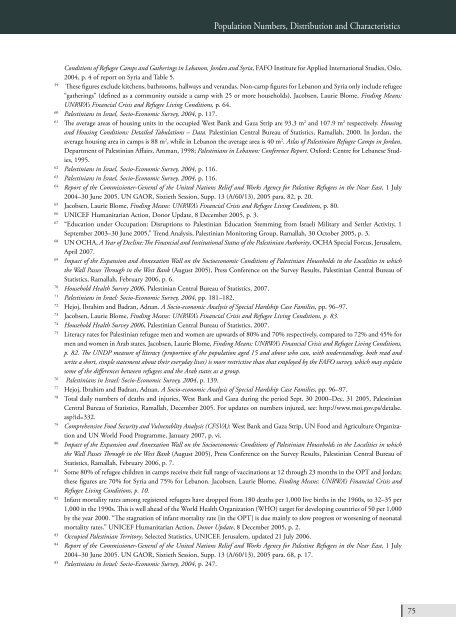BADIL Resource Center for Palestinian Residency and Refugee
BADIL Resource Center for Palestinian Residency and Refugee
BADIL Resource Center for Palestinian Residency and Refugee
Create successful ePaper yourself
Turn your PDF publications into a flip-book with our unique Google optimized e-Paper software.
Population Numbers, Distribution <strong>and</strong> Characteristics<br />
Conditions of <strong>Refugee</strong> Camps <strong>and</strong> Gatherings in Lebanon, Jordan <strong>and</strong> Syria, FAFO Institute <strong>for</strong> Applied International Studies, Oslo,<br />
2004, p. 4 of report on Syria <strong>and</strong> Table 5.<br />
59 These figures exclude kitchens, bathrooms, hallways <strong>and</strong> ver<strong>and</strong>as. Non-camp figures <strong>for</strong> Lebanon <strong>and</strong> Syria only include refugee<br />
“gatherings” (defined as a community outside a camp with 25 or more households). Jacobsen, Laurie Blome, Finding Means:<br />
UNRWA’s Financial Crisis <strong>and</strong> <strong>Refugee</strong> Living Conditions, p. 64.<br />
60 <strong>Palestinian</strong>s in Israel, Socio-Economic Survey, 2004, p. 117.<br />
61 2 2 The average areas of housing units in the occupied West Bank <strong>and</strong> Gaza Strip are 93.3 m <strong>and</strong> 107.9 m respectively. Housing<br />
<strong>and</strong> Housing Conditions: Detailed Tabulations – Data. <strong>Palestinian</strong> Central Bureau of Statistics, Ramallah, 2000. In Jordan, the<br />
average housing area in camps is 88 m2 , while in Lebanon the average area is 40 m2 . Atlas of <strong>Palestinian</strong> <strong>Refugee</strong> Camps in Jordan,<br />
Department of <strong>Palestinian</strong> Affairs, Amman, 1998; <strong>Palestinian</strong>s in Lebanon: Conference Report. Ox<strong>for</strong>d: Centre <strong>for</strong> Lebanese Studies,<br />
1995.<br />
62 <strong>Palestinian</strong>s in Israel, Socio-Economic Survey, 2004, p. 116.<br />
63 <strong>Palestinian</strong>s in Israel, Socio-Economic Survey, 2004, p. 116.<br />
64 Report of the Commissioner-General of the United Nations Relief <strong>and</strong> Works Agency <strong>for</strong> Palestine <strong>Refugee</strong>s in the Near East, 1 July<br />
2004–30 June 2005. UN GAOR, Sixtieth Session, Supp. 13 (A/60/13), 2005 para. 82, p. 20.<br />
65 Jacobsen, Laurie Blome, Finding Means: UNRWA’s Financial Crisis <strong>and</strong> <strong>Refugee</strong> Living Conditions, p. 80.<br />
66 UNICEF Humanitarian Action, Donor Update, 8 December 2005, p. 3.<br />
67 “Education under Occupation: Disruptions to <strong>Palestinian</strong> Education Stemming from Israeli Military <strong>and</strong> Settler Activity, 1<br />
September 2003–30 June 2005,” Trend Analysis, <strong>Palestinian</strong> Monitoring Group, Ramallah, 30 October 2005, p. 3.<br />
68 UN OCHA, A Year of Decline:The Financial <strong>and</strong> Institutional Status of the <strong>Palestinian</strong> Authority, OCHA Special Forcus, Jerusalem,<br />
April 2007.<br />
69 Impact of the Expansion <strong>and</strong> Annexation Wall on the Socioeconomic Conditions of <strong>Palestinian</strong> Households in the Localities in which<br />
the Wall Passes Through in the West Bank (August 2005), Press Conference on the Survey Results, <strong>Palestinian</strong> Central Bureau of<br />
Statistics, Ramallah, February 2006, p. 6.<br />
70 Household Health Survey 2006, <strong>Palestinian</strong> Central Bureau of Statistics, 2007.<br />
71 <strong>Palestinian</strong>s in Israel: Socio-Economic Survey, 2004, pp. 181–182.<br />
72 Hejoj, Ibrahim <strong>and</strong> Badran, Adnan. A Socio-economic Analysis of Special Hardship Case Families, pp. 96–97.<br />
73 Jacobsen, Laurie Blome, Finding Means: UNRWA’s Financial Crisis <strong>and</strong> <strong>Refugee</strong> Living Conditions, p. 83.<br />
74 Household Health Survey 2006, <strong>Palestinian</strong> Central Bureau of Statistics, 2007.<br />
75 Literacy rates <strong>for</strong> <strong>Palestinian</strong> refugee men <strong>and</strong> women are upwards of 80% <strong>and</strong> 70% respectively, compared to 72% <strong>and</strong> 45% <strong>for</strong><br />
men <strong>and</strong> women in Arab states. Jacobsen, Laurie Blome, Finding Means: UNRWA’s Financial Crisis <strong>and</strong> <strong>Refugee</strong> Living Conditions,<br />
p. 82. The UNDP measure of literacy (proportion of the population aged 15 <strong>and</strong> above who can, with underst<strong>and</strong>ing, both read <strong>and</strong><br />
write a short, simple statement about their everyday lives) is more restrictive than that employed by the FAFO survey, which may explain<br />
some of the differences between refugees <strong>and</strong> the Arab states as a group.<br />
76 <strong>Palestinian</strong>s in Israel: Socio-Economic Survey, 2004, p. 139.<br />
77 Hejoj, Ibrahim <strong>and</strong> Badran, Adnan. A Socio-economic Analysis of Special Hardship Case Families, pp. 96–97.<br />
78 Total daily numbers of deaths <strong>and</strong> injuries, West Bank <strong>and</strong> Gaza during the period Sept. 30 2000–Dec. 31 2005, <strong>Palestinian</strong><br />
Central Bureau of Statistics, Ramallah, December 2005. For updates on numbers injured, see: http://www.moi.gov.ps/detalse.<br />
asp?id=332.<br />
79 Comprehensive Food Security <strong>and</strong> Vulnerablity Analysis (CFSVA): West Bank <strong>and</strong> Gaza Strip, UN Food <strong>and</strong> Agriculture Organization<br />
<strong>and</strong> UN World Food Programme, January 2007, p. vi.<br />
80 Impact of the Expansion <strong>and</strong> Annexation Wall on the Socioeconomic Conditions of <strong>Palestinian</strong> Households in the Localities in which<br />
the Wall Passes Through in the West Bank (August 2005), Press Conference on the Survey Results, <strong>Palestinian</strong> Central Bureau of<br />
Statistics, Ramallah, February 2006, p. 7.<br />
81 Some 80% of refugee children in camps receive their full range of vaccinations at 12 through 23 months in the OPT <strong>and</strong> Jordan;<br />
these figures are 70% <strong>for</strong> Syria <strong>and</strong> 75% <strong>for</strong> Lebanon. Jacobsen, Laurie Blome, Finding Means: UNRWA’s Financial Crisis <strong>and</strong><br />
<strong>Refugee</strong> Living Conditions, p. 10.<br />
82 Infant mortality rates among registered refugees have dropped from 180 deaths per 1,000 live births in the 1960s, to 32–35 per<br />
1,000 in the 1990s. This is well ahead of the World Health Organization (WHO) target <strong>for</strong> developing countries of 50 per 1,000<br />
by the year 2000. “The stagnation of infant mortality rate [in the OPT] is due mainly to slow progress or worsening of neonatal<br />
mortality rates.” UNICEF Humanitarian Action, Donor Update, 8 December 2005, p. 2.<br />
83 Occupied <strong>Palestinian</strong> Territory, Selected Statistics, UNICEF, Jerusalem, updated 21 July 2006.<br />
84 Report of the Commissioner-General of the United Nations Relief <strong>and</strong> Works Agency <strong>for</strong> Palestine <strong>Refugee</strong>s in the Near East, 1 July<br />
2004–30 June 2005. UN GAOR, Sixtieth Session, Supp. 13 (A/60/13), 2005 para. 68, p. 17.<br />
85 <strong>Palestinian</strong>s in Israel: Socio-Economic Survey, 2004, p. 247.<br />
75

















